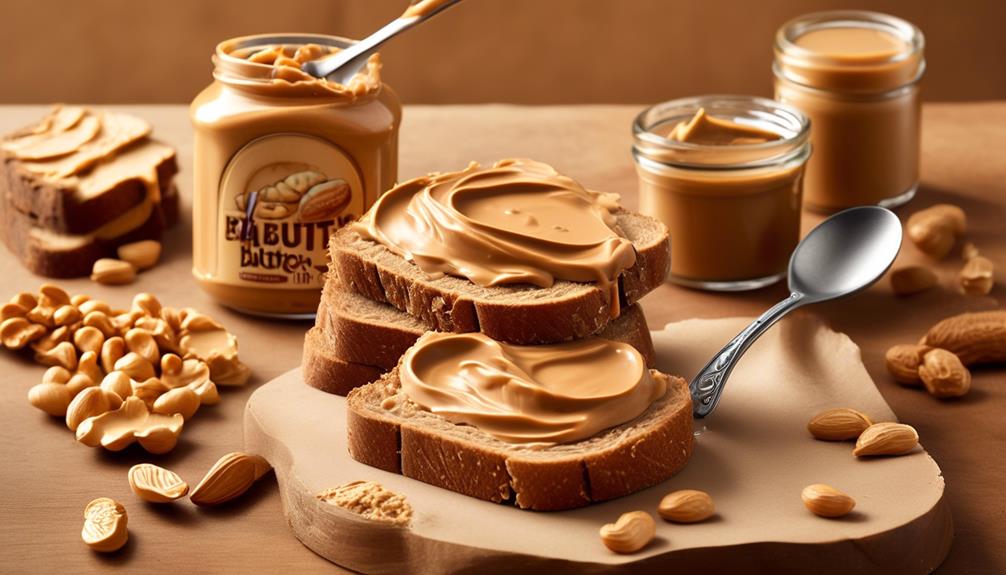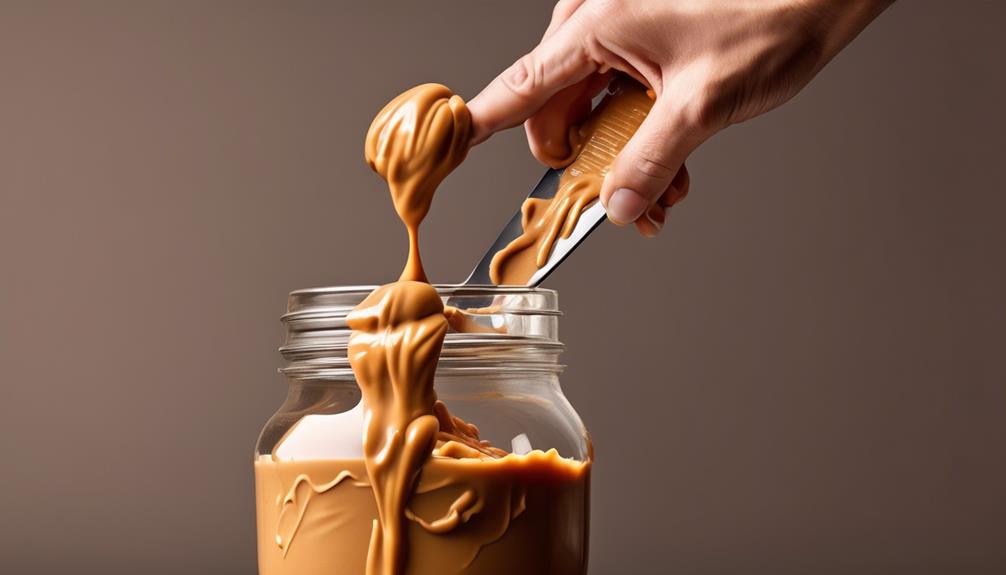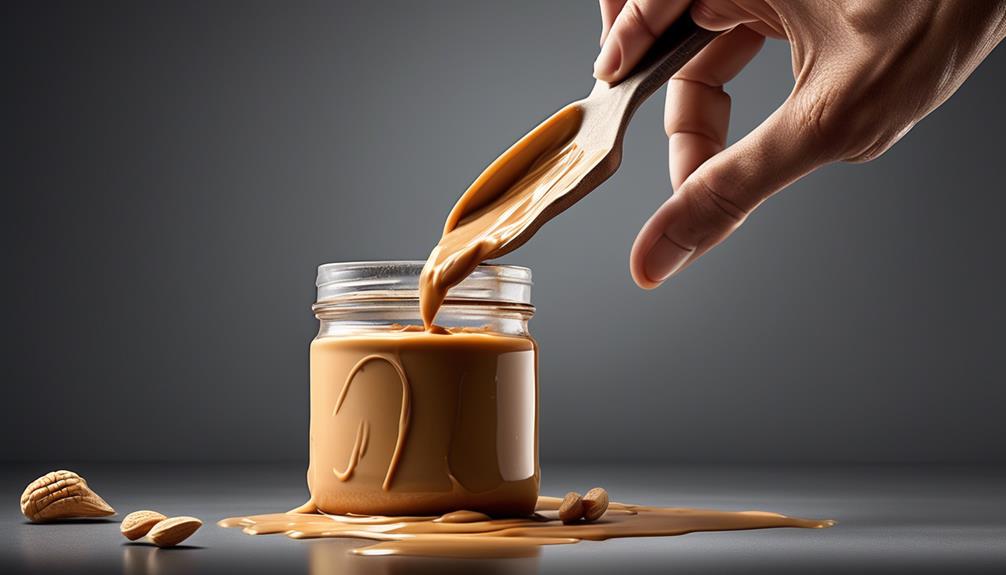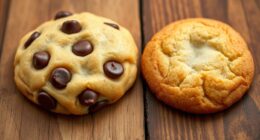When trying to measure out 2 tablespoons of peanut butter, it can feel like trying to catch a couple of clouds in a jar – it seems easy, but can be surprisingly tricky. We have all experienced this, questioning if we are actually getting the correct amount.
But fear not, because we're about to uncover the truth behind this seemingly innocuous task. So, how much is 2 tablespoons of peanut butter, and why does it matter?
Well, let's just say it's not as straightforward as it seems, and the implications might surprise you.
Key Takeaways
- Paying attention to serving sizes is important for managing calorie intake and maintaining a balanced diet.
- A serving size of peanut butter is 2 tablespoons, providing around 190 calories and 16g of fat.
- Using measuring tools like cups and spoons helps accurately portion out serving sizes of peanut butter.
- Understanding portion control and serving sizes can help prevent overeating, support weight management, and promote healthy eating habits.
Understanding Serving Sizes
Understanding serving sizes is essential for managing calorie intake and ensuring a balanced diet. By paying attention to serving sizes on nutrition labels, we can make informed food choices that contribute to our overall well-being. It's easy to overlook portion sizes, especially when it comes to calorie-dense foods like peanut butter.
A serving size of peanut butter is 2 tablespoons, providing around 190 calories and 16g of fat. These numbers might seem small, but they can add up quickly, impacting our daily calorie intake. We've found that using measuring tools, such as measuring cups and spoons, can help accurately portion out serving sizes. This practice has been incredibly helpful in maintaining a healthy diet.
It's about more than just following a set of rules; it's about understanding how much we're consuming and how it contributes to our overall nutrition. With a better understanding of serving sizes, we can take charge of our calorie intake and make choices that align with our health goals.
Importance of Portion Control

Paying attention to portion sizes on nutrition labels has been crucial for us in managing our calorie intake and making informed food choices. When it comes to weight loss and maintaining a healthy lifestyle, portion control plays a significant role. Here are a few reasons why we've found portion control to be essential:
- Weight Loss: Controlling portion sizes can prevent overeating and aid in weight management, making it easier to achieve our weight loss goals.
- Promoting Healthy Eating Habits: Proper portion control can help prevent excessive calorie consumption and promote balanced nutrition, allowing us to enjoy a variety of foods without overindulging.
- Preventing Overeating: Being mindful of portion sizes can help prevent overeating, which can contribute to weight gain and potential health issues. By paying attention to portion control, we can enjoy our favorite foods while maintaining a balanced diet.
Understanding the importance of portion control has allowed us to make positive changes in our eating habits, leading to better overall health and well-being.
Peanut Butter Measurement Guide

We carefully measure our peanut butter using a kitchen scale to ensure accurate portion control and a consistent serving size.
When it comes to peanut butter, 2 tablespoons weigh approximately 32 grams or 1.13 ounces, which is equivalent to a quarter cup weighing around 65 grams or 2.3 ounces.
These 2 tablespoons of peanut butter pack approximately 190 calories, 16g of fat, 7g of protein, and 3g of sugar, making it a nutrient-dense food.
To maintain portion control and manage calorie intake, it's important to be mindful of the weight when serving peanut butter. By using a kitchen scale, we can ensure that we're getting an accurate 2-tablespoon serving, which provides a good balance of healthy fats and protein.
Understanding the weight of peanut butter helps in managing calorie consumption, especially for those with specific dietary goals. Whether you're trying to watch your calorie intake or looking to enjoy a balanced serving of peanut butter, being mindful of the weight ensures you get the nutritional benefits without overindulging.
Calorie Content of 2 Tablespoons

With 190 calories, 2 tablespoons of peanut butter provide a substantial source of energy and essential nutrients. It's not just about the calories; these two tablespoons offer a balanced nutritional profile, making them a satisfying addition to your diet.
Here's what you get with this serving size:
- A generous dose of heart-healthy mono and polyunsaturated fats, helping to support overall health.
- A decent amount of protein, which can help keep you feeling full and satisfied.
- A good serving of fiber, contributing to digestive health and promoting a feeling of fullness.
These 2 tablespoons of peanut butter are more than just a flavorful spread; they're a nutrient-dense addition to your meals or snacks.
Nutritional Value Breakdown

Analyzing the nutritional value breakdown of 2 tablespoons of peanut butter reveals a rich source of essential nutrients and a balanced macronutrient profile. This wholesome spread offers a notable amount of protein, healthy fats, fiber, and essential vitamins and minerals. The table below illustrates the nutritional content of a 2-tablespoon serving of peanut butter.
| Nutrient | Amount | Daily Value (DV) |
|---|---|---|
| Calories | 188 | – |
| Protein | 7g | 14% |
| Total Fat | 16g | 25% |
| Carbohydrates | 6g | 2% |
The Daily Value (DV) tells us that 2 tablespoons of peanut butter contribute to 14% of the recommended daily protein intake, 25% of the recommended daily fat intake, and 2% of the recommended daily carbohydrate intake. Additionally, it contains essential nutrients such as vitamin E, niacin, and magnesium, which play vital roles in supporting overall health. Understanding these nutritional aspects can aid in making informed decisions about incorporating peanut butter into a well-balanced diet.
Converting Tablespoons to Grams

Exploring the nutritional value breakdown of 2 tablespoons of peanut butter, it becomes important to understand how to accurately convert tablespoons to grams for precise measurement, especially when used in recipes. Converting tablespoons to grams is crucial for maintaining portion control and achieving the desired consistency in cooking and baking.
Here are a few key points to consider when converting tablespoons to grams:
- Precision Matters: Converting tablespoons to grams helps ensure accuracy in serving sizes, which in turn contributes to a daily intake that aligns with dietary goals.
- Weight Management: Understanding the weight of a tablespoon of peanut butter in grams can be beneficial for individuals keeping track of their calorie and macronutrient intake.
- Recipe Consistency: Converting tablespoons to grams is essential for maintaining the consistency and texture of dishes, especially in baking where precise measurements are crucial for the final outcome.
Knowing how to convert tablespoons to grams not only aids in using peanut butter as a good source of protein and healthy fats but also supports overall weight management and contributes to a balanced daily diet.
Impact on Weight Management

Peanut butter can be a valuable addition to a weight management plan due to its nutrient density and satiating properties. Its ability to increase fullness and reduce appetite can aid in weight loss. The protein content in peanut butter also supports the preservation of muscle mass during weight loss. Furthermore, incorporating peanuts and peanut butter into a balanced diet is not associated with weight gain and may even help with weight maintenance. It's important to practice portion control and choose varieties without additives for a healthful consumption of peanut butter. The combination of protein and healthy fats in peanut butter makes it a satisfying addition to a weight management program.
| Impact on Weight Management |
|---|
| Increases fullness and reduces appetite |
| Supports muscle mass preservation during weight loss |
| Not associated with weight gain |
| Helps with weight maintenance |
| Satisfying addition to a weight management program |
Incorporating Into Meal Plans

After understanding the impact of peanut butter on weight management, we can now explore its incorporation into meal plans for a balanced and satisfying diet. Incorporating peanut butter into daily meal plans can be both delicious and nutritious.
Here are some simple yet effective ways to do so:
- Use peanut butter as a protein-rich spread for breakfast toast or as a dip for fruit or veggies for a balanced meal.
- Incorporate peanut butter into smoothies or oatmeal for a quick, satisfying, and nutritious meal or snack.
- Experiment with using peanut butter as a base for savory sauces or dressings to add depth and flavor to your meals.
Peanut Butter in Recipes

When it comes to using peanut butter in recipes, it's important to pay attention to the measurements.
We can explore how to substitute peanut butter in recipes and the various ways to spread it.
Let's discuss the versatility of peanut butter and how it can be incorporated into both sweet and savory dishes.
Measurement in Recipes
In recipes, accurately measuring peanut butter using a measuring spoon is crucial for ensuring the desired flavor and consistency. When it comes to measurement in recipes, here are some tips for using peanut butter:
- Soften the peanut butter to make it easier to measure accurately.
- Use a rubber spatula to level off the peanut butter in the measuring spoon for precise measurement.
- Consider using a kitchen scale for even more accurate measurements, especially in recipes where the ratio of ingredients is crucial.
Accurate measurement ensures that the flavor and texture of the dish turn out just right. Whether it's a decadent peanut butter cake or a nutritious smoothie, getting the measurement right is key to a successful outcome.
Substituting Peanut Butter
Substituting peanut butter in recipes offers versatile options for achieving desired flavors and textures. Almond or cashew butter can be used as alternatives, offering a slightly different dimension to the dish due to their unique flavor profiles.
For those aiming for a nut-free option, sunflower seed butter is a great substitute. It provides a similar creamy texture and nutty flavor without the presence of peanuts.
If you're looking to cut down on fat content, powdered peanut butter mixed with water can be used as a lower-calorie alternative in recipes.
When substituting peanut butter in baking recipes, it's important to adjust the moisture levels in the recipe to accommodate the different consistency of the substitute.
Spreading Peanut Butter
Spreading peanut butter on toast or crackers adds a delicious creamy texture and nutty flavor to a snack or meal. When spreading peanut butter, consider the thickness and coverage needed for the dish or snack.
Here are some tips for spreading peanut butter:
- Opt for creamy or chunky peanut butter based on personal preference and the texture desired for the dish.
- Warm the peanut butter slightly to make it easier to spread, especially if it's a bit thick.
- Use a butter knife or spatula to spread the peanut butter evenly, ensuring that every bite has a perfect amount.
Spreading peanut butter can be a delightful experience, enhancing the taste and texture of your favorite recipes.
Health Benefits of Peanut Butter

Peanut butter offers a range of health benefits, including being a good source of protein, healthy fats, fiber, and essential vitamins and minerals. These nutrients are vital for our overall well-being, and incorporating peanut butter into our diet can have a positive impact on our health. Here's a quick look at the health benefits of peanut butter:
| Health Benefits of Peanut Butter |
|---|
| 1. Good source of protein |
| 2. Rich in healthy fats |
| 3. High in fiber |
| 4. Contains essential vitamins and minerals |
| 5. Supports weight loss and maintenance |
Incorporating peanut butter into our daily meals can provide us with the nutrients needed for a healthy body. It's essential to consume it in moderation, considering its caloric content, to maintain a balanced diet. However, the benefits of peanut butter go beyond just the nutrients it provides. Research suggests that it can aid in weight loss, boost fat loss, and increase feelings of fullness, ultimately supporting a healthy lifestyle. As with any food, it's important to consume peanut butter mindfully, but its health benefits make it a valuable addition to our diet.
Comparing Different Peanut Butter Brands

When it comes to comparing different peanut butter brands, we need to consider the nutritional content, price per ounce, and ingredient variations.
It's important to look at the protein, fat, sugar, and additional health benefits in each brand to find the best fit for our dietary needs.
Additionally, exploring variations in texture, such as smooth, crunchy, or creamy, can help us find the perfect peanut butter for our taste and recipe requirements.
Nutritional Content Comparison
Comparing different peanut butter brands reveals variations in nutritional content, including protein, healthy fats, fiber, vitamins, and minerals.
When examining the nutritional content of various peanut butter brands, we found that:
- Protein levels can differ, impacting the amount of muscle-building and repairing nutrients.
- Healthy fat content may vary, influencing heart health and satiety.
- The fiber content might differ, affecting digestive health and promoting a feeling of fullness.
These variations highlight the importance of scrutinizing nutritional labels when selecting peanut butter.
Whether it's the vitamin E, magnesium, potassium, or antioxidant content like resveratrol, each brand offers a unique nutritional profile.
Being mindful of these differences empowers us to make informed choices that align with our health and wellness goals.
Price per Ounce
After researching various peanut butter brands, we discovered significant variations in price per ounce, prompting us to carefully consider the most cost-effective option for our purchase. When comparing different peanut butter brands, we found that price per ounce ranged from as low as $0.08 to as high as $0.20.
This considerable difference in price per ounce highlights the importance of evaluating various options to ensure we get the best value for our money. Not only does understanding price per ounce help in making more informed purchasing decisions, but it also allows us to assess the cost efficiency of different peanut butter brands.
Ingredient Variations
Considering the significant variations in price per ounce among different peanut butter brands, we now turn our attention to the ingredient variations, comparing the offerings across various brands.
When it comes to peanut butter, ingredient variations can greatly influence taste and nutritional value. Here are a few key differences to consider:
- Sweeteners and Additives: Some brands incorporate added sugars, preservatives, or artificial flavors, while others stick to just peanuts and salt.
- Texture: From smooth and creamy to chunky and crunchy, the texture of peanut butter can vary widely between brands.
- Nutritional Content: Different brands may have varying levels of protein, healthy fats, and fiber, so it's essential to check the nutritional labels for specific health benefits.
Exploring these ingredient variations can help us make informed choices when selecting the best peanut butter for our needs.
Practical Tips for Measuring

When measuring peanut butter, it's helpful to use a spatula to transfer it into the measuring spoon to ensure an accurate measurement. This technique helps in filling the entire measuring spoon without leaving any gaps or air pockets, which could lead to an inaccurate measurement. Additionally, leveling off the peanut butter with a straight edge ensures precision in the measurement. To make this process easier, consider using a spatula to smoothly transfer the sticky peanut butter into the measuring spoon. Here are some practical tips for measuring peanut butter effectively:
| Practical Tips for Measuring Peanut Butter |
|---|
| Use a spatula to transfer peanut butter into the measuring spoon. |
| Level off the peanut butter with a straight edge for accuracy. |
| Clean the measuring spoon thoroughly to prevent cross-contamination. |
| Fill the entire measuring spoon without any gaps or air pockets. |
| Consider using a spatula for easier transfer of sticky substances. |
These tips will not only help you measure 2 tablespoons of peanut butter accurately but also ensure consistency in your recipes. Happy measuring!
Avoiding Overconsumption

To maintain a balanced approach to consuming peanut butter, we must be mindful of portion sizes to prevent overconsumption of calories and fat. It's important to be aware of how much peanut butter we're consuming to avoid overdoing it and potentially exceeding our daily calorie and fat intake.
Here are some practical tips to help us avoid overconsumption:
- Choose natural peanut butter with minimal added ingredients or additives to reduce the risk of overconsumption of sugar, hydrogenated oils, or sodium.
- Use measuring tools to accurately portion out 2 tablespoons of peanut butter to prevent overconsumption and track calorie intake.
- Incorporate peanut butter into balanced meals and snacks to prevent overconsumption by pairing it with fiber-rich foods like fruits, vegetables, or whole grains.
Peanut Butter and Fitness Goals

Incorporating peanut butter into our fitness goals can support our efforts with its nutrient-dense profile, aiding in weight loss, appetite reduction, and muscle preservation. The table below outlines the nutritional benefits of peanut butter, demonstrating its potential to enhance our fitness journey.
| Nutrient | Amount per 2 tbsp | Benefits |
|---|---|---|
| Protein | 8g | Supports muscle preservation and repair |
| Healthy Fats | 16g | Aids in satiety and nutrient absorption |
| Fiber | 2g | Helps with digestive health and fullness |
| Vitamins/minerals | Vitamin E, magnesium | Supports overall health and energy levels |
Peanut butter provides a balanced mix of macronutrients and essential micronutrients, making it a valuable addition to a fitness-oriented diet. Its protein content can aid in muscle preservation and repair, while the healthy fats and fiber contribute to satiety and digestive health, aligning with our fitness goals. When consumed in moderation, peanut butter can be a beneficial component of a well-rounded diet, supporting weight management and overall health. Integrating peanut butter into our fitness journey offers a delicious and nutritious way to pursue our wellness objectives.
Expert Recommendations

As we consider expert recommendations for consuming peanut butter, it's essential to pay attention to serving size recommendations and the nutritional value breakdown. Understanding these points will help us make informed choices about incorporating peanut butter into our diets.
Serving Size Recommendation
Expert recommendations for serving sizes of peanut butter take into account factors such as age, sex, activity level, and overall health status, ensuring balanced consumption based on individual dietary needs and goals.
When determining the appropriate serving size of peanut butter, it's crucial to consult with a nutrition professional who can provide personalized guidance. Understanding expert serving size recommendations can empower individuals to make informed choices that support their nutritional needs.
Nutritional Value Breakdown
When considering the nutritional value breakdown of peanut butter, it's important to understand how its protein, healthy fats, fiber, vitamins, and minerals contribute to overall health and well-being.
| Nutrient | 2 Tablespoons of Peanut Butter |
|---|---|
| Protein | 7-8 grams |
| Healthy Fats | 16 grams |
| Fiber | 2 grams |
| Vitamins | Vitamin E, Niacin |
| Minerals | Magnesium, Phosphorus |
Peanut butter offers a significant amount of protein, contributing to a feeling of fullness and aiding in weight management. Its healthy fats, including oleic acid, promote heart health. Additionally, the fiber content supports digestion and helps maintain stable blood sugar levels. The presence of essential vitamins and minerals, such as vitamin E and magnesium, further enhances its nutritional value. Understanding the nutritional breakdown of peanut butter can empower individuals to make informed choices to support their overall well-being.
Frequently Asked Questions
How Do You Measure 2 Tablespoons of Peanut Butter?
We measure 2 tablespoons of peanut butter by using a measuring spoon and leveling off the top for accuracy. It's essential to note that this amount equals approximately 32 grams or 1.13 ounces and contains around 190 calories.
For precise measurements, a kitchen scale is beneficial, and using the back of a spoon to level off the peanut butter in the measuring spoon ensures an accurate portion.
How Much Does 1 Tbsp of Peanut Butter Look Like?
We measure 1 tbsp of peanut butter as approximately 16 grams or 0.6 ounces. It's just the right amount to spread on a slice of bread or add to oatmeal for flavor and protein.
It's also handy for precise measuring using a standard spoon or scale. This quantity offers a convenient way to incorporate peanut butter into various recipes, giving a delightful touch of creaminess and flavor.
What Does 2 Tablespoon Look Like?
We often use 2 tablespoons of peanut butter in our energy ball recipe. It's about the size of a ping pong ball when scooped with a regular eating spoon. This amount provides a good balance of flavor and nutrition for the recipe.
It's also perfect for spreading on a couple of slices of bread for a satisfying snack.
Is Two Tablespoons of Peanut Butter a Lot?
Two tablespoons of peanut butter may seem like a lot to some, but it's essential to consider portion sizes in relation to your overall diet. While it provides valuable protein and healthy fats, excessive intake can lead to consuming too many calories and fats.
It's all about balance and moderation in our approach to food. As with any nutrient-dense food, it's crucial to enjoy it in appropriate amounts for optimal health benefits.
Conclusion
So, next time you're reaching for that jar of peanut butter, remember that 2 tablespoons equals about 32 grams or 1.13 ounces.
That's roughly the weight of a small lemon, which is a lot more than you might think!
Keep an eye on your portions and enjoy this delicious spread in moderation for a healthy and balanced diet.









